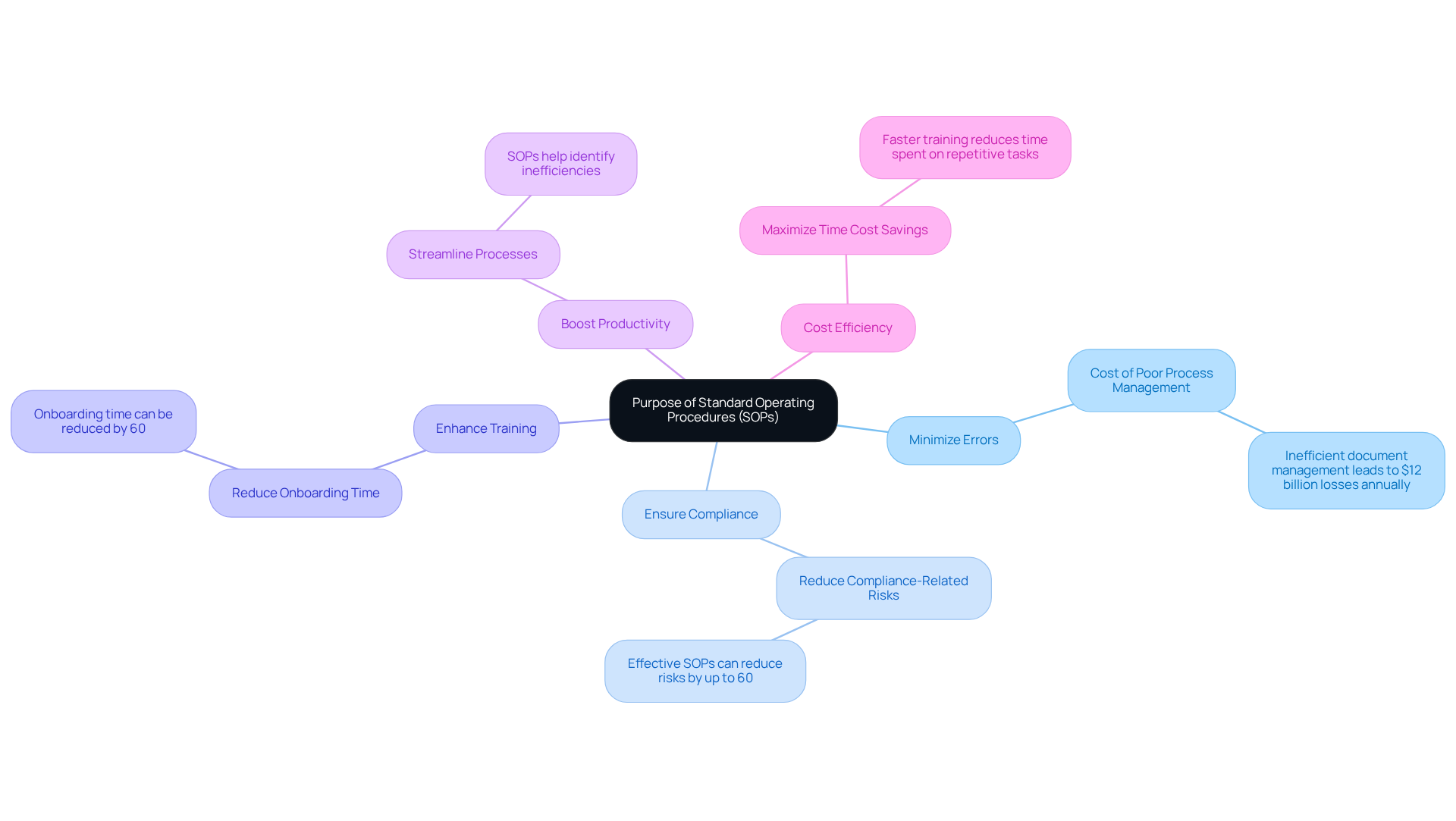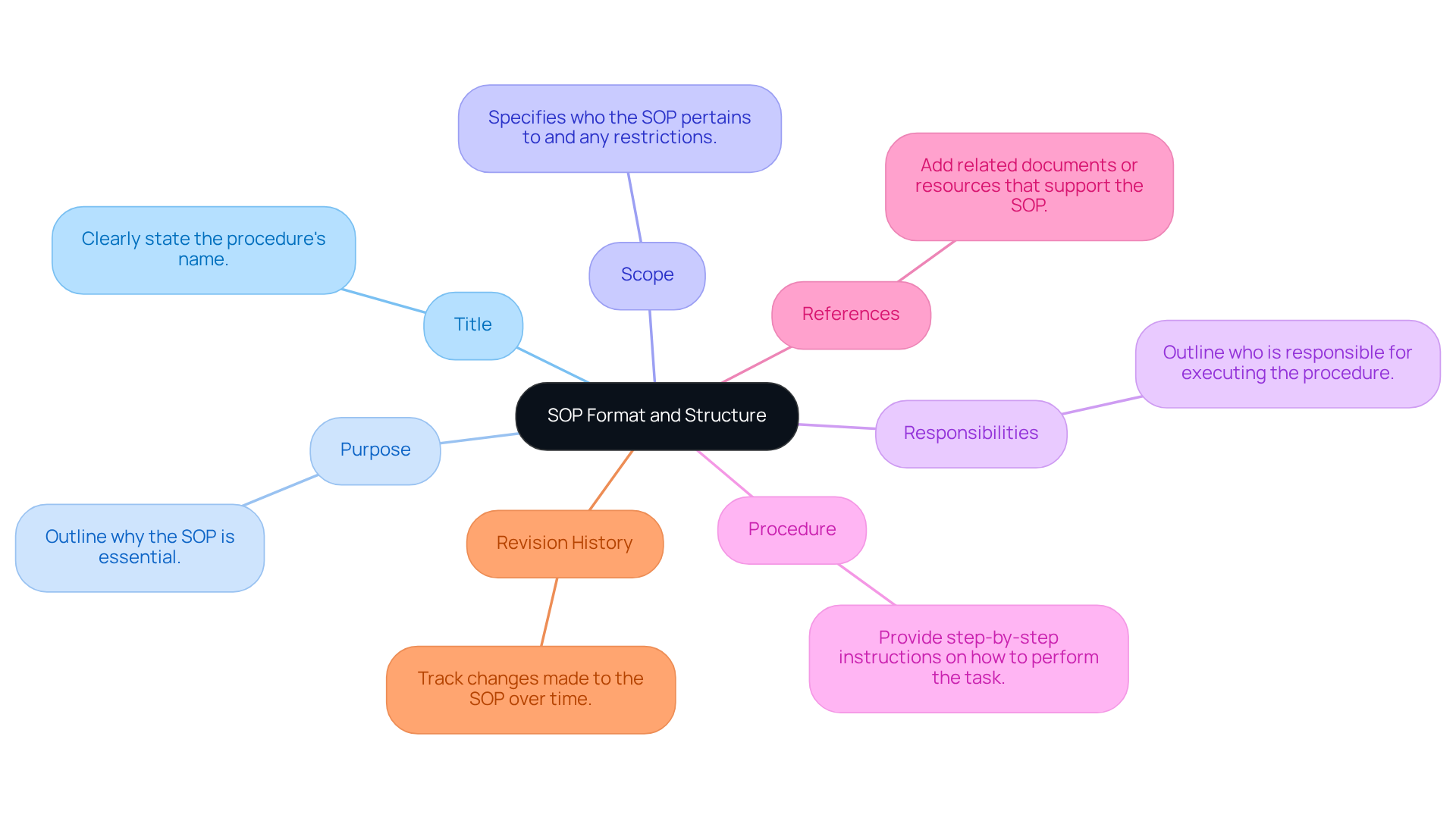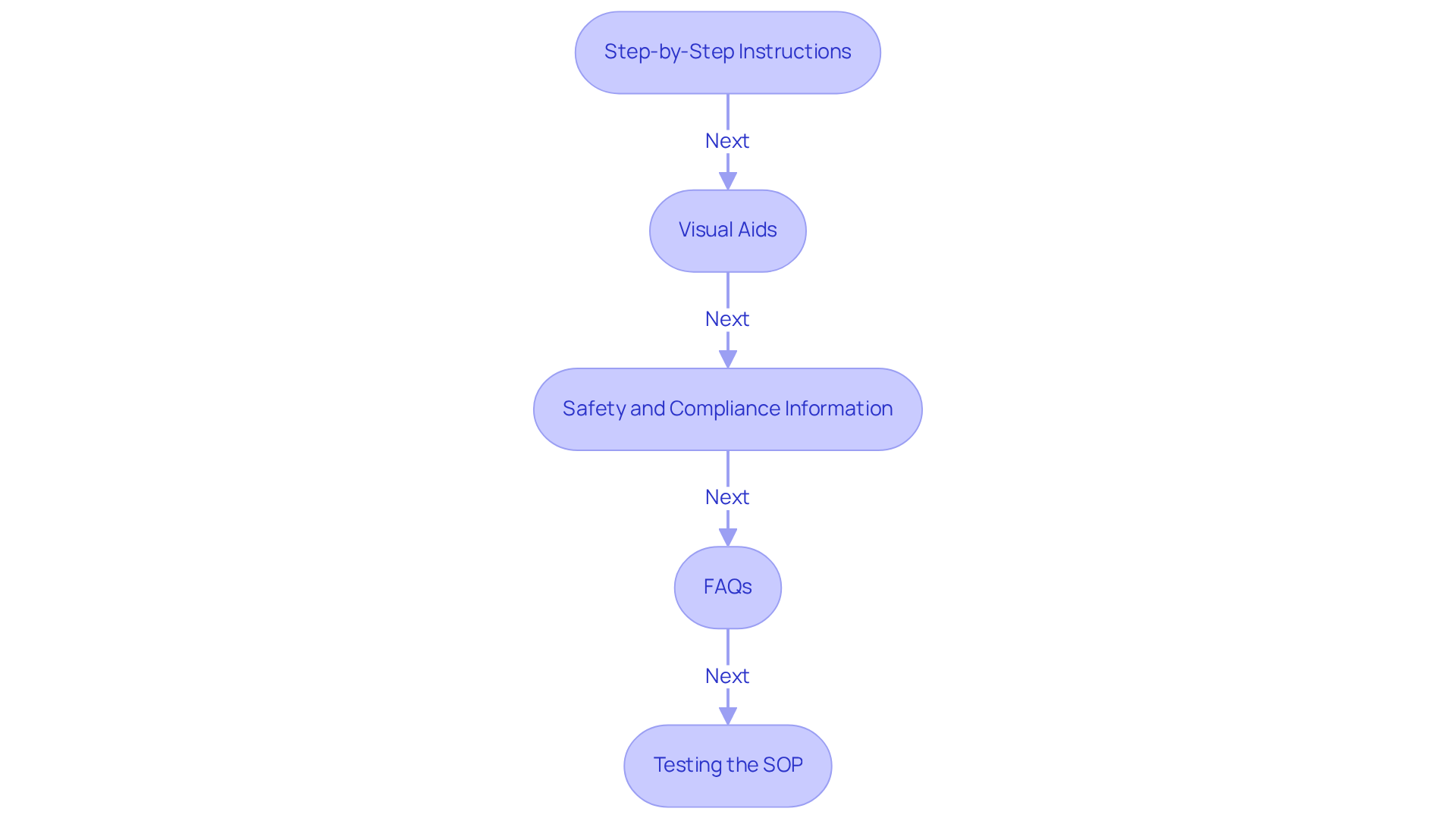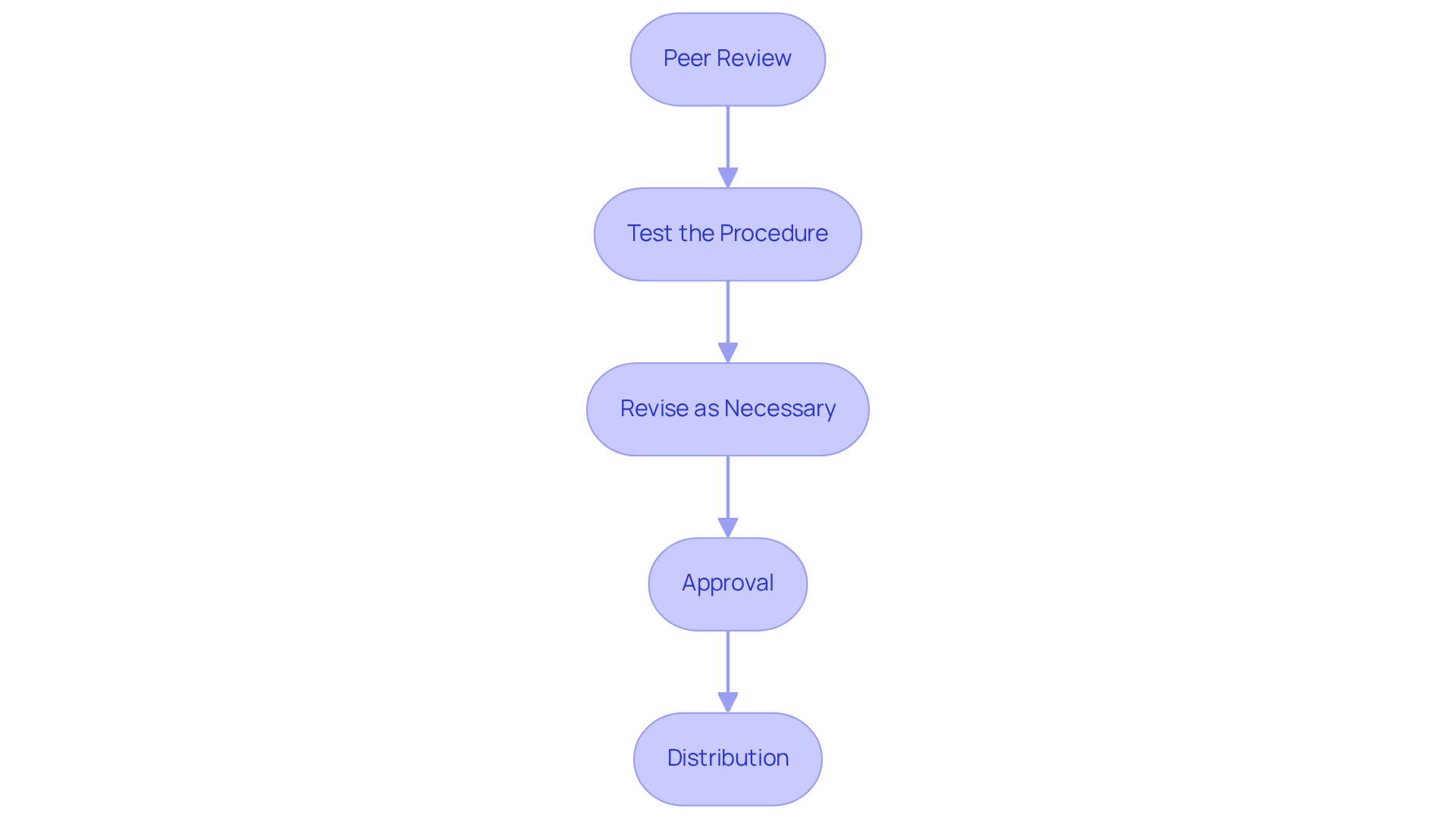
Overview
You might be wondering how to create a Standard Operating Procedure (SOP) that really works. Well, it’s all about laying out clear instructions and key components like:
- Purpose
- Scope
- Responsibilities
- Step-by-step procedures
This not only boosts efficiency but also helps with compliance in your organization. Speaking of which, effective SOPs can really make a difference—they can:
- Cut down errors
- Speed up onboarding by as much as 60%
- Lower compliance-related risks by the same amount
Isn’t that impressive? It really shows just how crucial they are for achieving operational excellence.
Key Highlights:
- SOPs provide clear instructions for tasks, minimising errors and ensuring compliance.
- Organisations with well-defined SOPs outperform competitors by 31%.
- SOPs can reduce onboarding time for new hires by up to 60%.
- Effective SOPs decrease compliance-related risks by as much as 60%.
- Inadequate process management can cost firms an average of $12 billion annually.
- The SOP software market is projected to reach USD 2.5 billion by 2033, indicating growing recognition of SOPs.
- Key elements of an effective SOP include Title, Purpose, Scope, Responsibilities, Procedure, References, and Revision History.
- Structured SOPs lead to a 30% decrease in deviations and a 50% reduction in training time.
- Incorporating visual aids and safety information enhances SOP usability and compliance.
- Regular reviews and updates of SOPs are essential to maintain relevance and effectiveness.
Introduction
Creating a solid framework for your organizational tasks is super important in today’s fast-paced business world. You might be wondering, what’s the deal with Standard Operating Procedures (SOPs)? Well, they really are the backbone of operational consistency! They provide clear guidelines that not only streamline your processes but also boost compliance and make training a breeze.
But here’s the catch: many organizations find it tricky to craft effective SOPs, which can leave them open to errors and inefficiencies. So, how can teams make sure their procedures are not just well-structured but also flexible enough to adapt to changing needs?
This guide is here to walk you through the essential steps for creating impactful SOPs that can really drive productivity and operational excellence. Let’s dive in!
Understand the Purpose of Standard Operating Procedures (SOPs)
You might be wondering how to create a standard operating procedure and why they are such a big deal for organizations. Well, they provide clear instructions on how to create a standard operating procedure for performing tasks consistently and effectively, which is super important! Think about it: knowing how to create a standard operating procedure helps minimize errors, ensure compliance with regulations, and make training new employees a breeze. Research even shows that organizations with well-defined SOPs outperform their competitors by a whopping 31%! That’s a strong case for fostering a structured work environment.
By offering clear reference points, SOPs align everyone with the organization’s processes and standards. This alignment can significantly boost productivity and cut down on operational chaos. For example, companies that implement SOPs can reduce onboarding time by up to 60%! That means new hires can become effective contributors much faster—just look at the case study involving TechCorp.
And it doesn’t stop there! Effective SOPs can also decrease compliance-related risks by as much as 60%, protecting organizations from potential liabilities, as noted by Deloitte. On the flip side, inadequate process management can cost firms an average of $12 billion annually. Yikes! This really highlights how crucial SOPs are in preventing costly inefficiencies.
In summary, knowing how to create a standard operating procedure not only enhances training and compliance but also lays the groundwork for operational excellence. They enable teams to function more efficiently and effectively. Plus, did you know the SOP software market is projected to reach USD 2.5 billion by 2033, growing at a CAGR of 9.2%? That’s a clear sign of the increasing recognition of the value of SOPs in today’s business landscape. So, let’s keep exploring how these procedures can elevate your organization!

Define the SOP Format and Structure
Establishing a clear format and structure is super important when learning how to create a standard operating procedure. You might be wondering what makes an effective SOP stand out. Well, it typically includes a few essential elements that really help.
First up, there's the Title: This is where you clearly state the procedure's name. Then, you have the Purpose: Here, you briefly outline why the SOP is essential, highlighting its role in keeping things compliant and running smoothly. Next, don’t forget the Scope: This specifies who the SOP pertains to and any restrictions, ensuring all relevant stakeholders are in the loop.
Now, let’s talk about Responsibilities: It’s crucial to outline who is responsible for executing the procedure, which promotes accountability within the team. Moving on to the Procedure: This is where you provide step-by-step instructions on how to perform the task, breaking down complex processes into manageable actions to make it user-friendly. You’ll also want to include References: This means adding any related documents or resources that support the SOP, ensuring comprehensive guidance. Finally, keep a Revision History: Tracking changes made to the SOP over time is essential for maintaining compliance and relevance.
Did you know that research shows organizations with structured standard operating procedures see a 30% decrease in deviations and a 50% reduction in training time? By following a consistent format, your team can ensure that they understand how to create a standard operating procedure that is easy to read and comprehend, which is key for effective implementation. And here’s a tip: engaging stakeholders in the SOP development process can really enhance clarity and foster buy-in, leading to smoother adoption and improved compliance. So, why not start refining your SOPs today?

Incorporate Essential Components and Details
Understanding how to create a standard operating procedure is essential for creating an effective SOP that focuses on the components that enhance clarity and usability. You might be wondering what those key elements are. Let’s break it down:
- Step-by-Step Instructions: First things first, decompose the procedure into clear, actionable steps. Using bullet points or numbered lists can really improve readability and help users follow along easily. With this platform, you can whip up these guides effortlessly, keeping your documentation accessible and up-to-date.
- Visual Aids: Now, let’s talk visuals. Incorporating diagrams, flowcharts, or screenshots can illustrate those complex steps beautifully. Did you know that individuals perform tasks 323% better when guided by visuals rather than just text? That’s why visual aids are crucial for comprehension and retention. This platform makes it super easy to add these visual components into your SOPs, enhancing user understanding.
- Safety and Compliance Information: It’s also important to clearly outline any safety precautions and compliance requirements relevant to the procedure. By including straightforward instructions on hazards and legal requirements, you help ensure adherence to standards like OSHA, ISO, or FDA regulations. This keeps employees safe and compliant. Plus, with this system, you can quickly revise this information as regulations change, so your SOPs stay relevant and up-to-date.
- FAQs: Ever thought about addressing common questions or concerns that pop up while executing the SOP? This proactive approach can really help users navigate potential challenges. And hey, getting feedback from actual users is a great way to ensure the SOP is accurate and realistic. This system makes it easy to create that feedback loop, allowing for continuous improvement of your documentation.
- Testing the SOP: Finally, let’s not forget about testing the SOP. It’s essential to have someone unfamiliar with the procedure give it a go to verify clarity and practicality. The instant documentation solution from this company streamlines this process, enabling quick revisions based on testing outcomes.
By integrating these components, your SOP can serve as a comprehensive resource that demonstrates how to create a standard operating procedure for executing tasks accurately and efficiently. This innovative approach to documentation ensures that your teams have immediate access to the information they need, fostering a culture of efficiency and knowledge sharing. So, what do you think? Ready to enhance your SOPs?

Finalize and Review the SOP for Accuracy
Once you've drafted the SOP, it's super important to review how to create a standard operating procedure and finalize it for accuracy. So, how to create a standard operating procedure to make sure it’s effective? Let’s break it down:
- Peer Review: Why not get some colleagues or team members to take a look? Their feedback can be a game-changer for spotting errors and boosting clarity. Plus, the platform makes it easy for everyone to jump in and contribute without any hassle.
- Test the Procedure: If you can, run a trial of the SOP. This hands-on approach helps confirm that the instructions are clear and effective, giving you real-world insights into how it works. With this system, you can quickly tweak the SOP based on trial feedback, keeping it relevant and efficient.
- Revise as Necessary: After gathering feedback and results from testing, it’s time to make adjustments. Understanding how to create a standard operating procedure is key to achieving continuous improvement! This platform lets you update your documentation with ease, ensuring it stays aligned with current practices.
- Approval: Don’t forget to get formal approval from the relevant stakeholders. This step is crucial for ensuring everyone is on the same page regarding how to create a standard operating procedure that meets your organization’s standards. Use the platform’s features to streamline the approval process, so everyone can review and sign off efficiently.
- Distribution: Once everything’s finalized, share the SOP with all the relevant team members. Make sure it’s easily accessible! The platform provides immediate access to documentation, so you can skip the endless meetings and ensure everyone has the information they need right at their fingertips.
And remember, regularly reviewing and updating the SOP is essential to keep it in line with any changes in processes or regulations. This practice not only keeps it relevant but also reinforces its role as a valuable resource for your organization. With SowFlow, keeping your documentation up-to-date is a breeze, boosting productivity across your team.

Conclusion
Creating a standard operating procedure (SOP) is a crucial step for organizations looking to boost efficiency, compliance, and training effectiveness. You might be wondering how this works. By setting up clear and structured guidelines, businesses can cut down on errors, streamline processes, and build a culture of accountability among team members. The importance of SOPs really can’t be overstated—they’re the backbone of operational excellence and play a big role in overall organizational success.
Throughout this guide, we’ve highlighted why understanding the purpose of SOPs, defining their format, incorporating essential components, and finalizing them for accuracy is so important. Think about it: structured SOPs can significantly reduce onboarding time, lower compliance risks, and ramp up productivity. Engaging stakeholders during the development process and regularly reviewing SOPs are essential practices that help keep these documents relevant and effective.
So, where do we go from here? Organizations are encouraged to make the creation and maintenance of SOPs a top strategic priority. By investing in well-defined procedures, businesses can not only boost their operational capabilities but also set themselves up for sustainable growth in a competitive landscape. Embracing the value of SOPs is a proactive step toward achieving long-term success and creating a more efficient work environment. Now, let’s dive into how you can start this journey!
Frequently Asked Questions
What is the purpose of Standard Operating Procedures (SOPs)?
The purpose of SOPs is to provide clear instructions for performing tasks consistently and effectively, minimizing errors, ensuring compliance with regulations, and facilitating the training of new employees.
How do SOPs benefit organizations?
Organizations with well-defined SOPs outperform competitors by 31%, boost productivity, reduce onboarding time by up to 60%, and decrease compliance-related risks by as much as 60%.
What impact do SOPs have on new employee training?
SOPs significantly streamline the onboarding process, allowing new hires to become effective contributors much faster.
What are the financial implications of inadequate process management?
Inadequate process management can cost firms an average of $12 billion annually, highlighting the importance of effective SOPs in preventing costly inefficiencies.
What is the projected growth of the SOP software market?
The SOP software market is projected to reach USD 2.5 billion by 2033, growing at a CAGR of 9.2%, indicating the increasing recognition of the value of SOPs in the business landscape.
👍
What others are liking
5 Steps to outline your ideal documentation structure
5 MINS READ
Where to start the your journey of mapping out your ideal documentation structure, aligning it with the very heartbeat of your organization?
Defining a winning level of detail in your process
3 MINS READ
What is too much detail, and what is too little? This article described in that winning level detail about what detail is enough.





